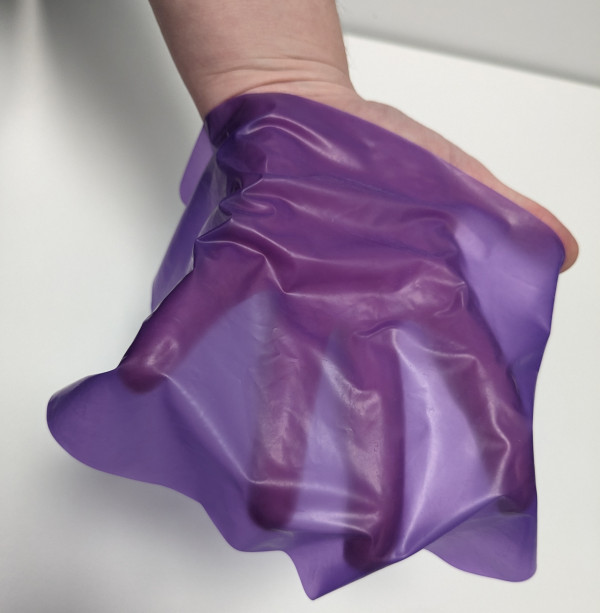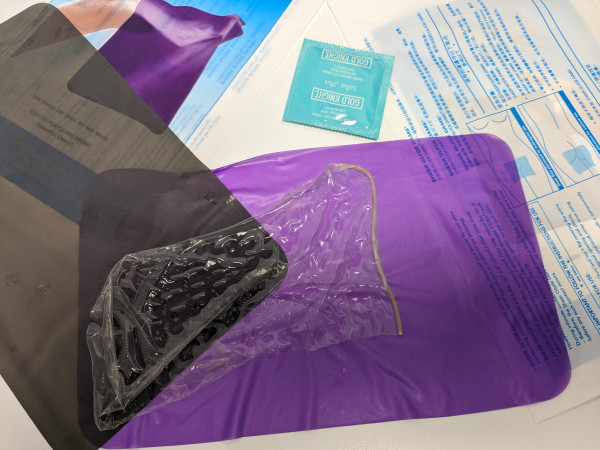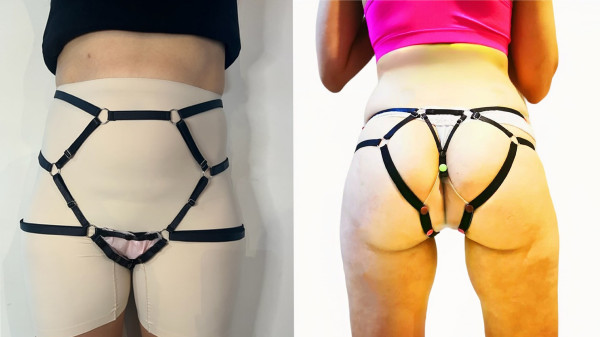One minute, you’re eating ass unprotected. The next minute, you’re spewing your guts out.
My friend Samantha, who is using a fake name because she doesn’t want her family to read this, says she got a “really nasty bacterial infection from giving someone a rim job”.
Her doctor told her she must have ingested a tiny bit of E. coli from unprotected rimming.
“It wasn’t pretty. I was violently throwing up out of both ends for two days straight,” she says.
Samantha says using a dental dam never crossed her mind and that dams were never brought up at any of her sexual health checkups.
“I don’t even know what one looks like or how to use it,” she says.
When we talk about using protection for sex, dental dams often get left out of the conversation.
A dental dam, also known as an oral dam or a sex dam, is a thin and soft sheet of latex that protects you during oral sex. Dams help prevent the spread of STIs and other bacteria while going down on a vulva or anus.
So why is it that a lot of people have never heard of them or used them?

A dental dam. Photo: supplied.
Not all protection is made equal
Dental dams protect against orally-transmitted STIs including chlamydia, gonorrhoea, genital herpes, syphilis and trichomoniasis, director of health promotion at Sexual Wellbeing Aotearoa Fiona McNamara says.
McNamara has worked in the sex and reproductive health field for 12 years.

Sexual Wellbeing Aotearoa director of health promotion Fiona McNamara. Photo: supplied.
She says Sexual Wellbeing Aotearoa, formerly called Family Planning, recommends people use dams when engaging in oral sex.
“We talk about dams in our education, show students what they look like, and promote their usage.”
But unlike condoms, dams are expensive and not easily available, McNamara says.
Condoms are funded by Pharmac which means you can get a three-month supply of up to 60 condoms for free if you have a prescription.
Condoms are also widely available for purchase and are sometimes freely given out in clinics but dental dams are not funded by Pharmac so you cannot get them on prescription, and you don’t often see them in supermarkets and pharmacies, she says.
McNamara says the staff working at Sexual Wellbeing Aotearoa clinics told her it's “quite rare” for dental dams to come up in conversation with patients.
She says a lot of people aren’t aware of dams so they haven’t been normalised.
The only reason I know what dental dams are is because I saw them get handed out for free every year at my university during Sex Week, a week dedicated to promoting healthy sex practices.
But if I was to try to buy those same dental dams now, it would cost me $7.95 for a pack of three.
Sex workers are big on using dental dams
Dame Catherine Healy says dental dams “are not very sexy looking” but they “got made popular by sex workers for good reasons”.
Healy is the national coordinator and one of the founding members of the Aotearoa New Zealand Sex Workers’ Collective.
She started working as a sex worker in 1986 and says she never saw any dams back then but remembers them becoming popular in the early-to-mid 90s.
Along with STIs, dental dams can protect sex workers from bacterial vaginosis and might help those with cystitis feel more comfortable when someone goes down on them, she says.

Aotearoa New Zealand Sex Workers’ Collective national coordinator Catherine Healy. Photo: supplied.
The Prostitution Reform Act 2003 requires sex workers and clients to take “all reasonable steps” to ensure they use protection against the transmission of STIs.
That includes dental dams.
While there has been some resistance from clients who aren’t keen on dams, “sex workers have done a remarkable job of promoting their use,” Healy says.
Healy acknowledges that dental dams aren’t cheap and says groups such as Positive Women, which supports women living with HIV, have tried to get dental dams funded but have not been successful.
Using dams
Healy says the uptake of dams seems to be increasing but they can be tricky to use because they can scrunch up.
Some people use water-based lube to help dams stick to the skin, others hold them in place with their hands, Healy says.
Dams are super stretchy so she says people could try sitting on a chair and wedging the dam under their bum, and then pulling it up over their vulva and holding it there while someone else performs oral sex on them.
Fiona McNamara from Sexual Wellbeing Aotearoa says you can make your own dental dams by cutting the tip off a condom and cutting down one side until you’re left with a latex square.
These DIY dams are a cheaper option to store-bought dams but they’re also smaller, she says.

A DIY dental dam made out of a condom, with dental dams behind it. Photo: supplied.
Designing solutions to make dams more usable
When Jessica Pereira’s daughter came home one day from sex education class at her school, she asked her mum what forms of protection women could use on their own bodies.
Pereira was stumped so she started researching and came across dental dams, she says.
She says she noticed dams were hard to use because they wouldn't stay put.
It gave Pereira the idea to start Intensas NZ with her business partner Angelina Leal in 2022.
Intensas NZ is a start-up company that is developing grip devices to hold dental dams in place over a vulva or anus.

Intensas’ grip devices will hold dental dams in place. Photos: supplied.
The devices look like harnesses that you wear over your hips and you can attach a dam to them using their in-built clips.
The clips help the dental dam stay in place - the less a dental dam moves around, the less likely someone is to have direct contact with bare skin.
The grip devices also look “sexy” and allow for hand-free sex, she says.
Intensas’ grip devices are patented and prototypes are currently being tested with sex workers.
Pereira aims to have the products ready for purchase on Intensas’ website by the end of the year.

Angelina Leal (left) and Jessica Pereira (right) at a Aotearoa New Zealand Sex Workers’ Collective conference. Photo: supplied.
Pereira is now working on designing a new kind of dam which will allow for penetration.
Dental dams were originally designed as a medical device to help dentists operate on a patient’s mouth.
But Pereira says the dams we use for sex should be made with sex in mind, not dental work.
Her ultimate goal is for people to have access to dams that can protect them during oral and penetrative sex.
That way, people can take full control of their own protection and will not need to depend on others, she says.
Until then, grab a condom and a pair of scissors — it’s time to get crafty.
More stories:
The Foreshore and Seabed hīkoi, 20 years on
A new doco shares the story of what happened in 2004.
Expectation vs. reality: International students on moving to NZ
International students think NZ is ‘safe, approachable, slow and free’
‘Horrific stats’: Rangatahi rally for mental health at Parliament
Advocacy group Mental Health Matters Initiative presented the Government with nine calls to action.